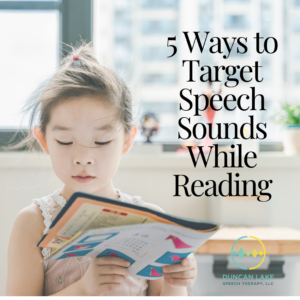The people have spoken, and they want to know what to do to help with their child’s speech at home!
At-home activities are a great way to carry over the work done during speech therapy sessions and to speed up progress. The ultimate goal is for children to use what they learn in speech across various settings. Since we are at home right now and many children aren’t receiving speech, it’s a great time to use some speechy-strategies throughout the day.
In my experience, books are the greatest speech tool ever. We have a ton of them around the house, and they are engaging. How can you utilize books to practice speech sounds? Easy!
Just a few notes: The book doesn’t matter. A 17 year old can read a picture book or a 5 year old can read the same book they have read a million times. The important piece is that they are practicing their sounds while doing an activity they like!
Additionally, read with your child to help give them feedback on their speech. While it’s good if they can read on their own and practice, it’s good for them to have some accountability as well! Gently correct. If possible, set up some rules for when/if they need to be corrected (how will you do it, etc.). You’ll have to decide how best to use these strategies based on your child’s skill level and frustration tolerance. Go with your gut!

Modeling
One of the most important things to do when your child is working on a specific set of speech sounds is to model the sound over and over…and over…AND OVER…again. The more correct models the child hears, the better their ability to differentiate between a correct/incorrect production will be. Whatever your child’s target sound(s) is/are, really emphasize that sound while you’re reading to them. Stretch out the sound! Say it loud! Whisper it so they have to ask you to repeat it! Modeling is a great way to help improve the sound production.
Let’s Listen
At the beginning of your reading session, tell your child, “Let’s listen for some words that have ____ in it.” Make a little hand signal or a noise (might I recommend a HONK!?) for when you hear the sounds in the book. It’s like a literary version of padiddle! You might need do a couple of models for your child to get the hang of it, but after a few times, they should take to it. Also, you don’t necessarily have to hit every single word that has the target sound on each page. Shoot for 1-3. Practice the sound together.
Pick Some Words
Another great strategy is to create a word list. At the beginning of the reading session, ask your child to listen for words that have their target sound. You can do one of two things:
- Have them tell you the words at the end of the page. Practice making the sounds accurately.
- If your child is able to write, have them write down 1-2 words per page that contain their target sound. Go over the list at the end and have them practice making the sounds accurately. What’s great about this strategy is that when the book is finished, your child will have a list of words they can practice INDEPENDENTLY throughout the week. They can practice the words by themselves, or they can make them into sentences depending on where your child is in their speech progress. Two birds, one stone.
Ask Questions
The previous strategies work largely with the single-word level of articulation. If your child is working on speech sounds within a short phrase or sentence, ask them questions during the reading session that have answers containing words with the target sounds. It doesn’t matter what you ask them, as long as it’s about something in the book and the answer has the speech sound in it. Even simple questions like, “What did he just say?” or “What’s that?” and point to an object in the illustrations will work. If they respond with a one-word answer, ask them to rephrase with a whole sentence. You might need to model it a few times, but they’ll catch on!
Read-Aloud
If your child is at a conversational level in their articulation and is able to read aloud, have them read to you! Come up with a strategy prior to reading – when will you correct them if needed? During the reading? At the end of each page? At the end of the book? If you get started and they’re having a really hard time keeping track of sound production, have them read it silently first and highlight or underline words with their target sounds ahead of time (if it’s something you can write in). You can gradually phase that out.
**
Minnesota State University, Mankato, has a list of picture books broken down by speech sound if you’re having a hard time thinking of books to use. Have a look at that! For older kids, feel free to use chapter books or graphic novels. Use the materials from your child’s distance learning curriculum to practice if you want to be very efficient (and if your child will let you…they may not want to do that).
If you have any other strategies, feel free to share below!



Recent Comments